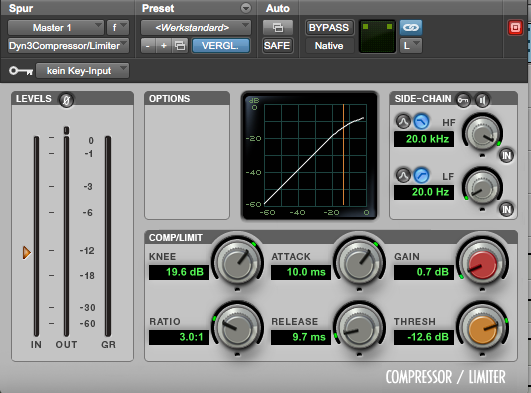
It’s amazing what proper balance, EQ and compression can do. Get this stuff right, and you’ll find you can often craft better mixes without these specialty tools. Multiband compressors can create artifacts between bands. (There’s a reason why mastering engineer John Scrip calls them “maul-the-band” compressors…)ĭo you really need all this stuff on your mix bus? Saturators can make a mix sound harsh and edgy. Saturators, stereo imagers, multiband compressors… You pile on specialty processingĪs modern mixers, we’ve got all sorts of fancy tools. Just crank the input gain until the mix starts to sound smaller. first off, you can lower master fader, you can put a gain plugin on master bus thats post processing, or you can group all your channels and lower the faders. Gain compensation makes it easy to determine the right amount of limiting for any mix. So as you add more limiting, there’s no change in level. When you turn the input up, the output turns down. This feature links the limiter’s input and output gain. Gain compensation makes it easy to determine the right amount of limiting for any mix. Limiters are the most dangerous tools we’ve got. You don’t use gain compensation on your limiter If you find yourself digging in deeper, make sure you’re not trying to solve a problem that can be fixed on an individual track (see #3 above). But most of the time, subtle is the way to go.īe gentle. Low-ratio compression and broad, tempered EQ curves often sound best. Sometimes, aggressive mix bus processing makes sense. Since slower attack times preserve transients, they’re usually a better choice (especially on the mix bus).

They add energy and life to music, and taming them can make a mix sound flat and unexciting. Transients are the short bursts of sound at the beginning of notes. You use fast-attack compressionĪt first listen, they can make a mix sound smoother and more controlled. Get this right, and you’ll optimize your mix bus for peak performance. So to get the most out of your mix bus, make sure you’re hitting it at the right level.Īim for around -18 dB on your DAW’s meters (this is average level…the peaks can jump above -18 dB). This will put you in the sweet spot of most plugins. Many plugins sound different depending on how hard you hit them. If your mix bus looks like this, you’ve got a problem…
#Cut gain mixbus how to#
Inside the guide, you’ll discover how to approach mix bus compression with clarity and confidence-which will help you craft mixes that compete with the pros.
#Cut gain mixbus download#
And if you want to supercharge your mix bus processing skills, download my free guide to mix bus compression below. When I listen to these tracks today, I cringe.Īvoid these nine pitfalls, and you’ll sidestep some of my biggest mix bus slip-ups. I crushed, slammed, distorted, over-compressed, and over-EQ’d nearly every mix I made. “What’s on your mix bus?” became my favorite ice breaker.īut along the way, I made every mistake in the book. I copied the chains of my favorite mixers. In the year that followed, I became obsessed with my mix bus.

I’ll never forget the first time I mixed on an SSL.įrom the moment I kicked it in and watched the meter dance, I was hooked.

I’ll never forget the first time I mixed on an SSL…Īnd when I automated stuff, the faders actually moved.


 0 kommentar(er)
0 kommentar(er)
